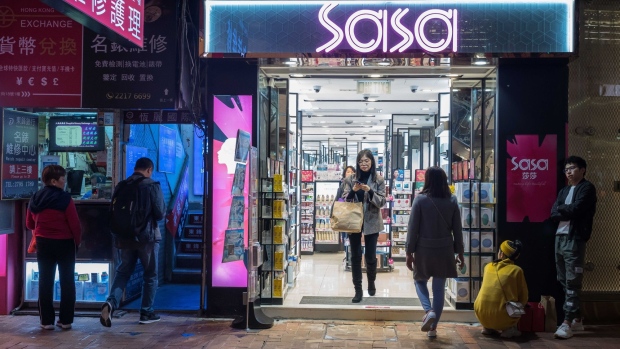Mar 28, 2023
Sa Sa’s Cautious Revival Shows Pessimism Over Hong Kong Recovery
, Bloomberg News

(Bloomberg) -- Hong Kong’s biggest cosmetics chain plans to open just a handful of new stores this year after shutting dozens during the pandemic as doubts remain that the city will return to its pre-Covid heights as a shopping mecca.
The cautious outlook from Sa Sa International Holdings Ltd. reflects broader pessimism over the pace of the financial hub’s economic recovery after Covid curbs were eased, with Chief Financial Officer Danny Ho expecting sales to take until 2026 to return to pre-pandemic levels, while tourists’ contribution to revenue may decline to 60% from 70%.
“We are quite conservative in terms of how much we think tourists will come back,” Ho said in an interview. “We don’t expect things to go back to previous highs.”
Sa Sa will open five to seven stores across Hong Kong and Macau this year, after its network in the cities shrank by a third in the past three years to about 80 stores as mainland China’s Covid Zero policy kept tourists away.
The company’s share price has fallen 2.8% this year, compared with a 1.9% gain in the benchmark Hang Seng Index.
One of Hong Kong’s bellwether consumer stocks, Sa Sa’s cautious outlook will add to doubts that Hong Kong can quickly restore its pre-Covid status as a financial and shopping hub after a rocky pandemic path in which erratic rules and an excruciatingly slow reopening damaged its reputation.
Read more: All the Obstacles Hong Kong Faces to Regain Its Former Hub Glory
The city also faces long-term challenges, including Chinese consumers shifting to buying more online and the rise of rival shopping hubs in Macau and the duty-free island of Hainan in China’s south, Ho said.
Hong Kong reported 1.5 million tourist visits in February, still down 74% from the same period in 2019. The neighboring casino hub of Macau reported 1.6 million visits in the same month, down 55% from 2019 levels.
Mainland China, the largest source of Hong Kong’s tourists, is seeing a slow recovery in both inbound and outbound travel, Trip.com Group Ltd. said in its 2022 annual report published this month. Residents have shifted their preferences to short-haul travel, local trips and domestic accommodation, it said.
Slow Return
In anticipation of a slow return of tourists, Sa Sa has been shifting its focus to local consumers, including selling more personal care products like shampoo and shower gel in addition to the cosmetics and skincare products typically favored by tourists, Ho said. The company has been developing its presence across social media platforms including Facebook, Instagram and YouTube, and is engaging with customers via messaging apps such as WeChat and WhatsApp, as well as doing more livestreaming, he said.
Sa Sa is also set to return to Singapore, where it shut all 22 stores during 2019-20 financial year after the business failed to make a profit, with plans to open one or two stores this year, Ho said. It’s also planning to open more stores in Malaysia, adding to its existing 71 shops, as a post-Covid tourism boom is expected to drive sales past 2019 levels in the next few months, he said.
In mainland China, where Sa Sa has 38 stores after halving its network during Covid, the company is focusing on making a profit at current operations, though may consider expanding in the second half, Ho said. Sa Sa is part of the Hong Kong Retail Management Association and is participating in discussions with authorities in Hainan to expedite registration for beauty products, which currently could take up to a year, he said.
“We’re making sure that we expand to other channels,” Ho said. While more tourists will come back to Hong Kong, “we have quite a conservative outlook so we are not banking on that.”
(Updates to add share price in fifth paragraph, additional comment in ninth.)
©2023 Bloomberg L.P.


